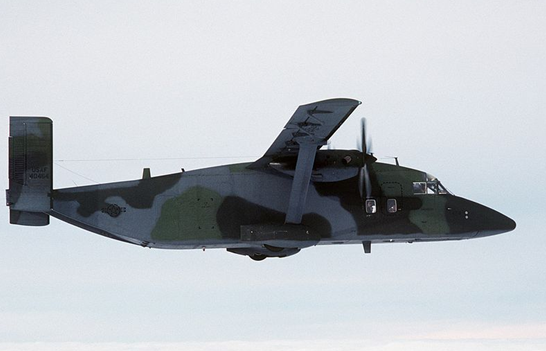

The Short C-23 Sherpa is a small military transport aircraft built by Short Brothers. The C-23A and C-23Bvariants are variants of the Short 330 and the C-23B+ and C-23C are variants of the Short 360.
Design and development
The Short 330 was developed by Short Brothers of Belfast from Short's earlier Short Skyvan STOL utility transport. The 330 had a longer wingspan and fuselage than the Skyvan, while retaining the Skyvan's square shaped fuselage cross section, allowing it to carry up to 30 passengers while retaining good short field characteristics. The 330 entered commercial service in 1976.
In addition to the passenger aircraft, Shorts also planned two freight versions. The first of these, the Short 330-UTT (for Utility Tactical Transport) was a military transport version fitted with a strengthened cabin floor, and paratroop doors, which was sold in small numbers, primarily to Thailand, who purchased four. The Short Sherpa(not to be confused with the earlier Short SB.4 Sherpa experimental aircraft) was a freighter fitted with a full width rear cargo door/ramp. This version first flew on 23 December 1982,with the first order for 18 aircraft being placed by theUnited States Air Force in March 1983. These aircraft were assigned to Military Airlift Command (MAC) for the European Distribution System Aircraft (EDSA) role, flying cargo and personnel between US Air Forces in Europe (USAFE) air bases.
In U.S. military service, the Short 330 was designated the C-23A Sherpa. The C-23B Sherpa was similar to the C-23A, but with cabin windows. The C-23B+ and C-23C Short 360 derivatives were created by replacing the rear fuselage of Short 360s obtained on the second-hand market with the twin tail and rear loading ramp of the Short Sherpa.
The C-23 was produced at the Short Brothers' facility in Belfast, Northern Ireland for the U.S. Dept. of Defense.
Operational history
The C-23A Sherpa entered USAF service in 1985 and continuing in use in the EDSA role until 1990, when the EDSA role was disbanded. Six aircraft were passed to the United States Army, where they were used to support the Army National Guard, joining 10 new build C-23B Sherpa aircraft. Other variants are C-23B+ and C-23C. The C-23 replaced the UV-18 Twin Otterin U.S. service. The C-23 is the only cargo plane operated by the U.S Army.
During Iraq War, 2003–present, the C-23 has served the Army's intra-theater needs of cargo and personnel transport. It provides an economic alternative for transporting some 20 people or 3 pallets of cargo when speed is not critical.
On 13 June 2007, the Alenia C-27J was selected to replace the C-23 in US Army service. A total of 43 C-23s were in service with the US Army as of November 2008.
Variants
C-23A Sherpa
Twin-engined transport aircraft for the US Air Force, fitted with a strengthened cabin floor with a roller conveyor system, plus a forward cargo door on the port side of the fuselage, equipped with a hydraulically operated full-width rear cargo door/ramp; 18 built.
C-23B Sherpa
Twin-engined transport aircraft for the US Army National Guard, similar to the C-23A, but fitted cabin windows; 16 built.
C-23B+/C Super Sherpa
Short 360 aircraft purchased as second-hand aircraft by the US Army and modified by The West Virginia Air Center (WVAC) by the replacement of the rear fuselage of the Short 360, with its single tall fin, with the twin tail and rear loading ramp of the Short Sherpa.



















